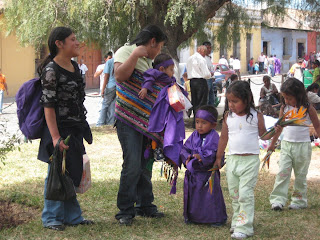On Sunday, James and I revved up the old Honda and drove to Antigua on a tip that the day's religious processionals would be worth the visit. There was so much going on it is hard to know where to start! We frankly still do not know what Holy Day we were there for.
A Brief History Lesson
you will be tested on the vocabulary in purple
you will be tested on the vocabulary in purple
Antigua's celebration of Semana Santa (Holy Week: from Palm Sunday - Easter Sunday) is partly derived from the Spanish missionaries that brought with them their own Andalusian celebration of Semana Santa, complete with religious orders carrying giant displays of Jesus carrying the cross, angels, holy displays and symbols, the Virgin Mother Mary, and eventually, Jesus' resurrection from the dead (Can I get an Amen?).
 No joke -- purple clothing in Antigua was
No joke -- purple clothing in Antigua wasinspired from these similar religious celebrations in Sevilla, Spain
Since I am really not very clear or knowledgeable about this, the description below is straight from this website. The pictures are ours from Sunday.
There are two type of carpets (alfombras) made during Semana Santa. The carpets along the processional route are made by residents along the route who invite friends and family to assist them. The carpets in the churches are made for the holy vigils (velaciones) and are made by the brotherhoods (hermandades).
Velaciones are held in the churches that have religious activities during the holiday. These carpets are made by members of the brotherhood responsible for the sculpture. The carpets are made in front of the religious figure on display and are surrounded by fruits, vegetables and candles brought as offerings to the church the day before.

The carpets along the processional route are made during the 24 hours prior to the procession. If more than one procession goes down a street a new carpet is made for each procession. Carpets express both religious as well as contemporary messages in the designs. Preparations for the carpets begin weeks, sometimes months, ahead.
Sand or sawdust is generally used to level the cobblestone roadway. Sawdust is then collected and dyed in different colors. Favorite colors are purple, green, blue, red, yellow and black. Flowers such as bougainvillea, chrysanthemums, carnations, roses and other native plants and pine needles are also used.
Carpets are started the day before the procession and the construction is timed so that the carpets are finished just before the carriers of the float arrive so that carpet looks its best. The carriers of the main float are the first ones allowed to walk over the carpet. They are followed the rest of the procession.
There is a velacióne before each procession. The Holy Vigils generally take place at the church the day before that Church's procession. The vigils are organized by a brotherhood, and there are different brotherhoods for each sculpture that will appear in the processions.
The sculpture is moved near the church altar in front of a huge decorative paper backdrop. A carpet is constructed in front of the sculpture. Around the carpet is a garden scene or huerto that includes fruit and vegetables, bread, candles, flowers and the native seed pod - the corozo. In the evening a funeral march band plays and outside the church a carnival atmosphere develops. Traditional foods and drinks and even games are available.

The religious processions are organized and carried out by the brotherhoods. The brotherhoods (los hermandades) were originally called cofradías and are religious organizations. The brotherhoods are either men or women, not both. It is thought that the carriers (cucuruchos) participated solely as a form of penance. Today there is some degree of social status involved but the principal motivation is still a show of devotion by the carriers.
Each procession leaves from its church and follows a route through the streets of Antigua before returning to the church several hours later. Purple is the color of the robes worn by the carriers up to Good Friday, then the robes are black to signify mourning.
Thousands of processional carriers participate in the processions. They are all members of the brotherhood that cares for the particular sculpture. Some have participated in processions all their lives.
Processions generally begin with incense carriers and the brotherhood's banner, followed by the carriers and the float (anda). Carriers will carry the float for a block and then a new group will take their turn. Each turn is determined by the carriers' shoulder height to ensure that the float is balanced. This is very important as the floats can weigh as much as 7,000 pounds (3,150 kilograms)!
A block behind the main float, the women carry a smaller float (size is relative here) with the figure of the Virgin Mary. The women wear white in their procession before Good Friday. Following behind is a funeral march band and two additional floats carrying the sculptures of San Juan and Maria Magdelena.





















2 comments:
Very interesting, although I can't say that I totally (or even partially) understand what all of it means! The pictures are beautiful though! :)
What beautiful pictures! Thanks for sharing.
Post a Comment